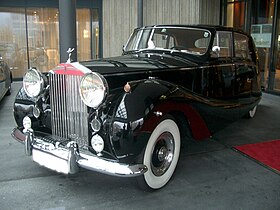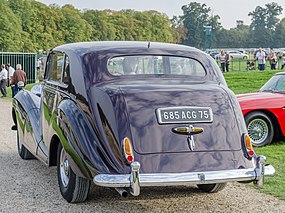
Back Rolls-Royce Silver Wraith Czech Rolls-Royce Silver Wraith German Rolls-Royce Silver Wraith Spanish Rolls-Royce Silver Wraith French Rolls-Royce Silver Wraith Italian ロールス・ロイス・シルヴァーレイス Japanese Rolls-Royce Silver Wraith Dutch Rolls-Royce Silver Wraith NB Rolls-Royce Silver Wraith Polish Rolls-Royce Silver Wraith Portuguese
| Rolls-Royce Silver Wraith | |
|---|---|
 1955 Silver Wraith, body by Hooper & Co | |
| Overview | |
| Manufacturer | Rolls-Royce Ltd |
| Production | 1946–1958 1883 produced (incl. 639 LWB cars) |
| Body and chassis | |
| Class | Full-size luxury car (F) |
| Body style | Mostly 4-door saloons, but other body styles were erected on this chassis. |
| Layout | Front-engine, rear-wheel-drive |
| Related | Rolls-Royce Silver Dawn |
| Powertrain | |
| Engine | 4.3 L (260 cu in) I6 (1946–51) 4.6 L (280 cu in) I6 (1951–55) 4.9 L (300 cu in) I6 (1955–58) |
| Transmission |
|
| Dimensions | |
| Wheelbase | 3225.8 mm (127 in) (1946–53) 3378.2 mm (133 in) (1951–58) |
| Chronology | |
| Predecessor | Rolls-Royce Wraith (1938) |
| Successor | Rolls-Royce Silver Cloud II LWB |

touring limousine by H J Mulliner

The Silver Wraith was the first post-war Rolls-Royce. It was made from 1946 to 1958 as only a chassis at the company's Crewe factory, its former Merlin engine plant, alongside the shorter Bentley Mark VI. The Bentley was also available as a chassis for coachbuilders, but for the first time could be bought with a Rolls-Royce built Standard Steel body. The use of the name "wraith" coincided with the established tradition of naming models after "ghosts".
It was announced by Rolls-Royce in April 1946 as the 25/30 hp replacement for the 1939 Wraith in what had been their 20 hp and 20/25 hp market sector, that is to say Rolls-Royce's smaller car. The size was chosen to be in keeping with the mood of post-war austerity. Even very limited production of the chassis of the larger car, the Phantom IV, was not resumed until 1950 and then, officially, only for Heads of State.[1]
Improvements announced were: chromium-plated cylinder bores for the engine; a new more rigid chassis frame to go with new independent front suspension; and a new synchromesh gearbox. Chassis lubrication was now centralised.[2]
- ^ Peter Pugh The Magic of a Name: The Rolls-Royce Story, Part 2: The Power Behind the Jets 2015 Icon Books. ISBN 1848319630, ISBN 9781848319639
- ^ News in Brief. The Times, Thursday, 4 April 1946; pg. 2; Issue 50418